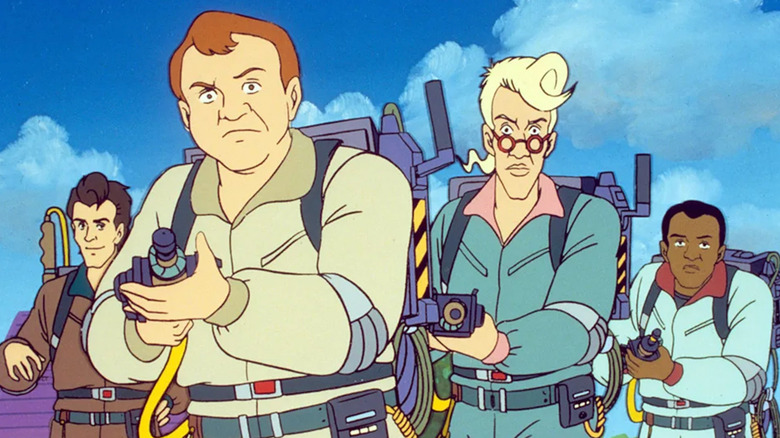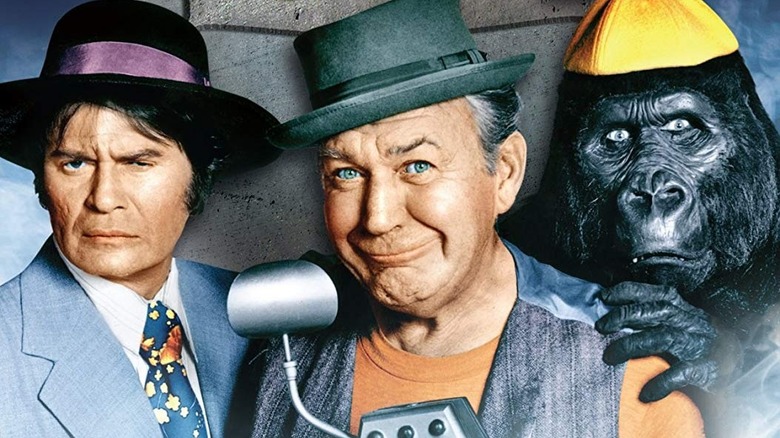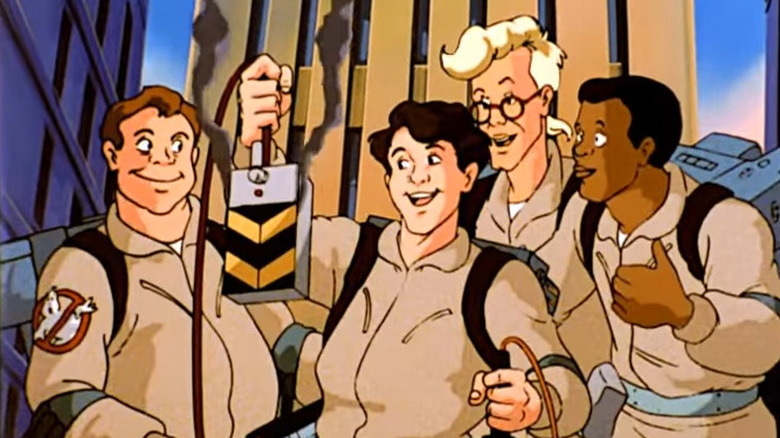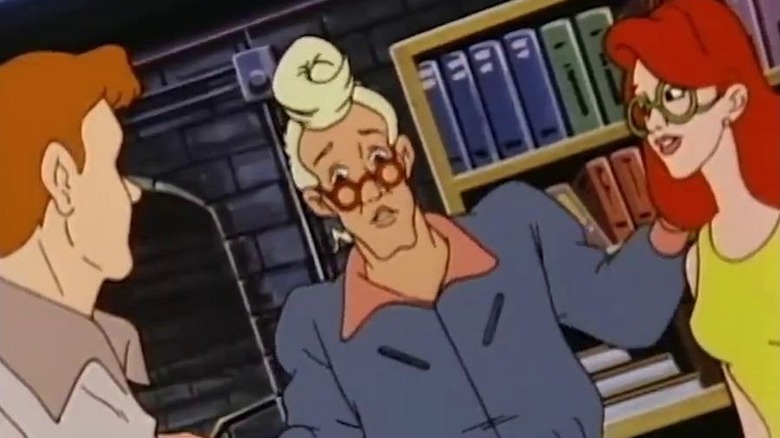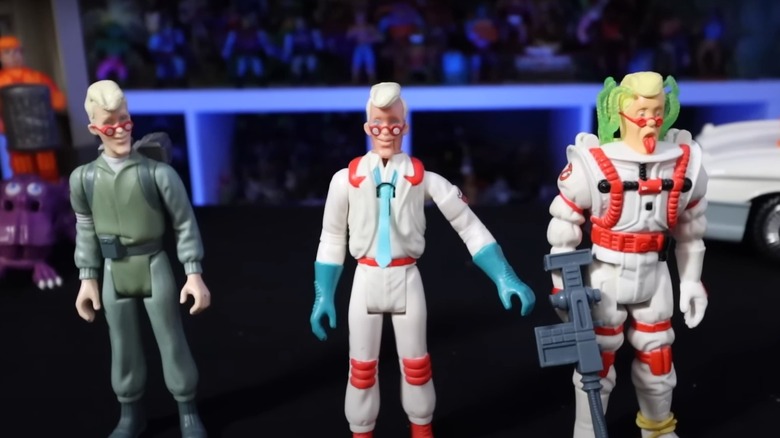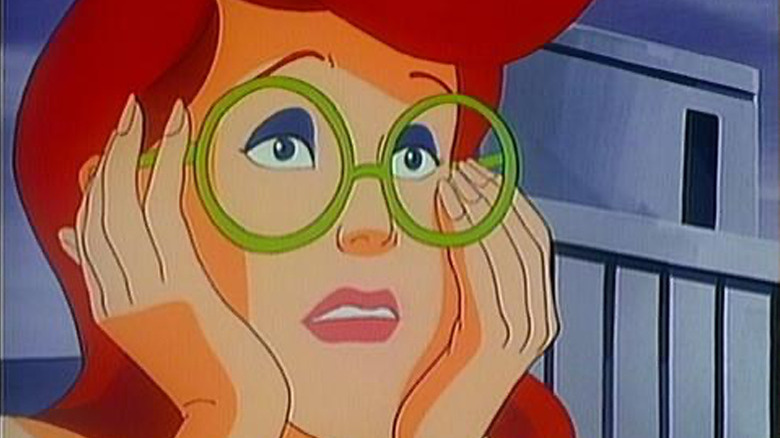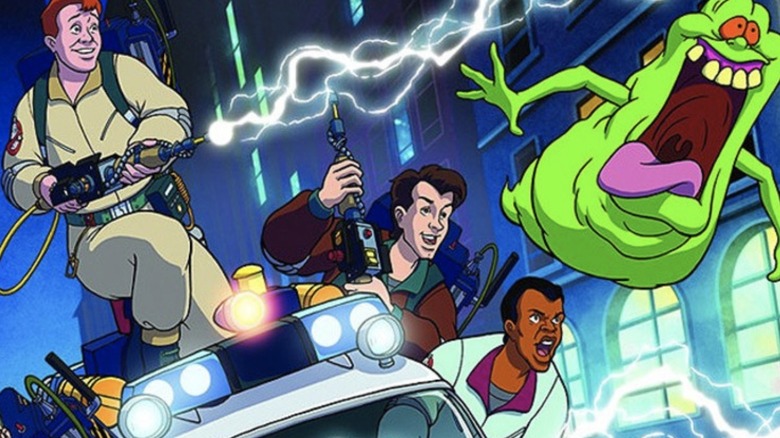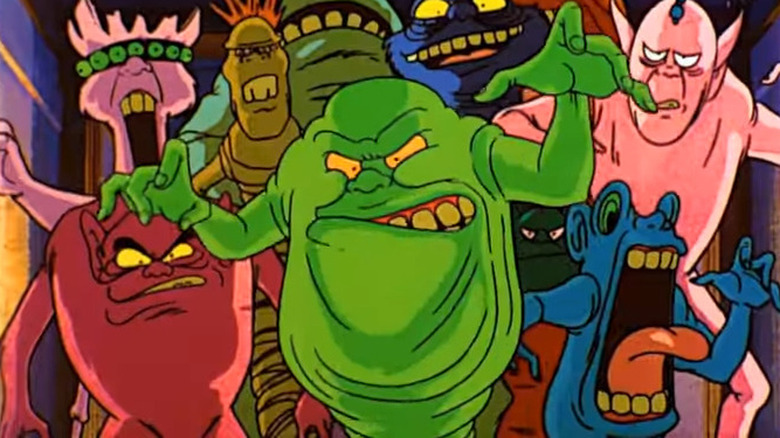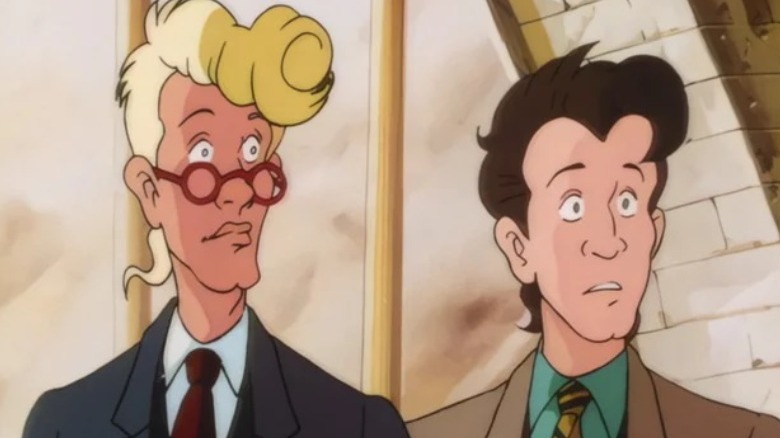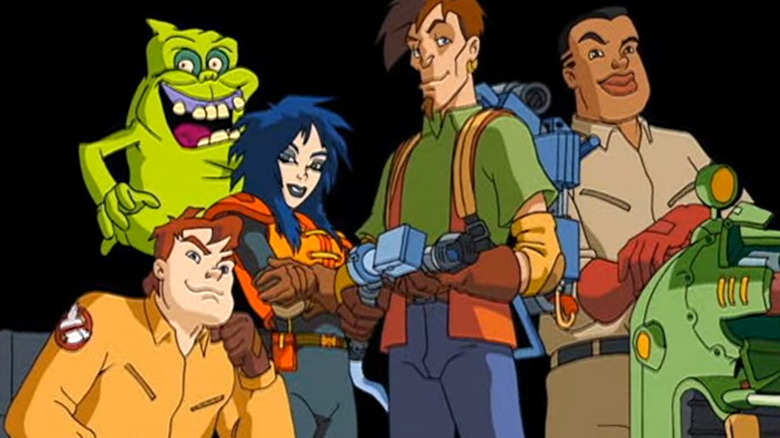The Complete History Of The Real Ghostbusters, The Animated Series You Probably Forgot About
When it comes to beloved pop culture staples, 1984's "Ghostbusters" is right up there, a film with a little bit of everything. The Ivan Reitman-helmed horror-comedy spawned sequels and an extended franchise that has seen a few new feature film entries in recent years. Even before those, "Ghostbusters" remained a consistent presence in the public consciousness thanks to its memorable characters and catchy theme tune. For some children who grew up in the 1980s, their first exposure to the world of the Ghostbusters was the animated series "The Real Ghostbusters."
Released in 1986, "The Real Ghostbusters" follows Peter, Ray, Egon and Winston as they embark on madcap supernatural adventures. Along for the ride is secretary Janine Melnitz and Slimer, a gross little specter who essentially operates as the gang's pet and mascot. This crowd-pleasing cartoon was a wild ride at times, but, for as vibrant and captivating as it could be, the history behind "The Real Ghostbusters" is just as interesting. So grab your proton packs because this is the complete history of "The Real Ghostbusters," the animated series you probably forgot about.
It's called The Real Ghostbusters because of two guys and their ape
You might be wondering why the "Ghostbusters" cartoon was called "The Real Ghostbusters" and not "Ghostbusters: The Animated Series" or something like that. It probably has something to do with the fact that CBS produced a live-action kids show called "The Ghost Busters" in the 1970s. "The Ghost Busters" follows two paranormal investigators and their gorilla companion as they hunt and deal with ghouls, using their Ghost De-Materializer to send them back to the netherworld. Columbia had already started shooting "Ghostbusters" when it found out about this, and a number of less-catchy alternatives were considered, including "Ghoststoppers" and "Ghostbreakers." The issue still hadn't been settled when it came to filming a scene in which members of the public chant "Ghostbusters" in the street. "I got on a payphone and called Burbank and said, 'You guys have got to clear that name,'" producer Joe Medjuck told Vanity Fair.
The name belonged to a production company called Filmation, who allowed Columbia to keep the name "Ghostbusters" in exchange for $500,000 and 1% of the profits. They didn't think to include potential animated spin-offs in the discussion, and when "Ghostbusters" became a hit, both Columbia and Filmation decided to make cartoons based on their properties. Filmation founder Lou Scheimer told The Trades that he wanted to team-up with Columbia to make a cross-over, but he couldn't get enough support. "Our parent company then, Westinghouse, said, 'Oh, we don't need them.' And I said, 'Bad idea. I think we need them. Because they'll have one, we'll have one, and nobody will know what's going on.' And as it turned out, that's essentially what happened."
It was almost more like the movie
During the development of "The Real Ghostbusters," a short test film was made to provide a sample of what the series would be. This isn't an uncommon practice in the world of animation. The test short for "Batman: The Animated Series" has all the hallmarks that the show would become beloved for and the design of Batman doesn't change. That's not the case with the "Ghostbusters" cartoon. Clocking in at about four minutes, the test short for "The Real Ghostbusters" is a bit different from the eventual series.
The short sees the boys contend with a bunch of different ghouls, with appearances from previously established ghosts like the Stay-Puft Marshmallow Man and the franchise's eventual mascot Slimer. It also showcases some new ghosts and creatures that the series would feature via its monster-of-the-week format. The feeling of the eventual series is there, but the main difference between the short and the show is that the Ghostbusters all look different from each other in the final product.
Rather than all wearing beige, the Ghostbusters wear clothing of various shades, presumably to help younger viewers tell them apart. The designs were all just different enough that they were distinct from their live-action variants. One major change is animated Egon having blonde hair. There is also Winston's lack of a mustache, and Venkman's lack of resemblance to Bill Murray.
Some of the voice cast still get fan mail
An animated series lives and dies on the quality of the voice acting. In the case of "The Real Ghostbusters," producers assembled a talented team of actors for the main cast. Providing the voice for Ray Stanz and Slimer, as well as countless other ghouls on the show, was the voice acting veteran Frank Welker, perhaps best known for his portrayal as Megatron on "Transformers." Next up, we have Janine Melnitz, the Ghostbusters' snarky secretary, voiced here by Laura Summer, best known as Patamon from "Digimon Adventure." According to Melnitz, she simply copied her mother's New York accent. "It wasn't as extreme as Janine's but she really spoke like that, so it was a very easy slip for me," she told Source Elements.
Stepping into the boots of Winston Zeddemore was talk show host and comedy legend Aresnio Hall. Then we have Maurice LaMarche, the man behind the Brain from "Pinky and the Brain," as the Ghostbusters' resident tech whizz Egon Spengler. According to LaMarche, he still gets fan mail from viewers all these years later. It has "tremendous staying power," he said in an interview included on the DVD release of "The Real Ghostbusters." The actor believes the show is living on because people who were kids at the time are now showing it to their own children and reliving their childhoods in the process. Last but certainly not least is Lorenzo Music — the animated voice of Garfield — as Peter Venkman.
The toy line was a big part of the show's success
You can't talk about "The Real Ghostbusters" without discussing the successful toy line. The 1980s saw a tsunami of cartoon-inspired action figures, dolls, and play sets. From "Transformers" and "Teenage Mutant Ninja Turtles" to "My Little Pony," there were a number of popular franchises in the toy stores. Back then, toy sales were a huge deal for a franchise. "Television programs that feature heroes and villains drawn from the toy-store shelf or developed in conjunction with the marketing of toys, once banned by Federal regulations, are booming in the free-market era of the current Federal Communications Commission," The New York Times reported in 1986. "Mattel's 'He-Man' line of toys, for example, featured in its own television series, brought in an estimated $350 million in sales last year."
Among these successful brands were the toys produced by Kenner for "The Real Ghostbusters," which were just as creative as the show itself. Today, the action figures and proton pack play sets are collectors items and can fetch thousands of dollars on the market. A can of colored ectoplasm in mint condition will set you back $2,000, per Good Find Toys. Kenner's "The Real Ghostbusters" toy line is remembered so fondly that Hasbro decided to bring it back in 2021. Its so-called Ghostbusters Kenner Classics line debuted with six figures: Peter, Ray, Winston, Egon, the Stay-Puft Marshmallow Man, and, of course, Slimer.
Changes to Janine's design caused some behind the scenes drama
In the late 1980s, ABC was keen to compete in the kids market, and the network wanted to make sure it was getting the most out of its cartoons. Execs turned to the Q5 Corporation, a consultancy firm that used cold, hard data to inform marketing decisions. They decided that Janine was not child-friendly enough, and the character got a major overhaul. Initially, the Ghostbusters' secretary was presented in a very mature way, with decade-appropriate hair, pointy glasses, and a feisty attitude. Come Season 3, gone were her sharp glasses and more angular hair, replaced by a softer and more gentle design. The new design was "warmer" according to Jennie Trias, ABC's vice president of children's programs, but not everyone agreed with the changes.
Speaking to the Los Angeles Times in 1987, story editor J. Michael Straczynski said that Q5 wanted them to "knock off all the corners" when it came to Janine's look. "Janine was a strong, vibrant character. They wanted her to be more feminine, more maternal, more nurturing, like every other female on television." He went on to call Q5 "a truly insidious organization" and accused it of making tone deaf decisions. "I think they reinforce stereotypes — sexist and racist. I think they are not helping television, they are diminishing it." Straczynski has not softened his stance over the years. In 2018, he went into more detail about Q5's overhaul of Janine in a tweet, claiming that the character's iconic pointy glasses were axed because the firm's research showed that sharp things scared kids. "I said show me your data. They fell back on High Priest logic, PhDs etc."
Some voice actors were swapped out
Going hand-in-hand with her Q5-ordered redesign, Janine's original voice actor Laura Summer was replaced with Kath Soucie, the woman behind Maddie Fenton on "Danny Phantom" and Mom from "Dexter's Laboratory." Janine's transformation was so jarring that the writers of the show came up with an episode titled "Janine, You've Changed." The episode provides an in-universe explanation for Janine's altered voice and appearance. It's revealed that Janine had been using a fairy godmother — later revealed to be an evil entity — to change her looks via supernatural means.
Janine wasn't the only character who was voiced by more than one actor over the course of the show's seven seasons. Venkman's voice actor Lorenzo Music was swapped out for David Coulier from "Full House" fame toward the end of Season 2 (Coulier later reprised the role in "Extreme Ghostbusters"). Winston also had a change in voice actor, going from Arsenio Hall to Buster Jones in Season 4. Jones also played Blaster on "Transformers," making him an important figure in '80s pop culture.
Slimer takes centerstage
Alongside the Stay-Puft Marshmallow Man, Slimer is the most recognizable ghost in the "Ghostbusters" canon by a wide margin. Speaking to Bloody Disgusting, special effects artist Steve Johnson confirmed that the Slimer seen in the film was inspired by the late John Belushi. The role of Venkman was written for Belushi, but he died before the film was made. His friends on the cast thought that this would be a great way to honor him, even if it meant a total overhaul at the last minute for Johnson. "I'd been working for six months sculpting hundreds of Slimer variations, and they finally said, 'Make him look more like Belushi,' and I said, 'What the f*** are you talking about?'"
It might have sounded like an odd request, but it was clearly the right call, as viewers reacted well to Slimer and the green ghost quickly became the unofficial mascot of the franchise. Slimer's increased popularity led to progressively more screen time dedicated to him on "The Real Ghostbusters," especially in the show's later seasons. The show cemented this elevated status by changing its name to "Slimer! and the Real Ghostbusters" in Season 4. This new name and format brought with it an additional 30-minute segment that usually had three short Slimer cartoons in it.
The creators were given a lot of freedom at first
In the early days of "The Real Ghostbusters," the creative team had a lot of freedom when it came to the content of the show, which was part of the appeal for them. "I loved it enormously, because it was really an opportunity to cut loose and be very obscure, to bring all the classics of science fiction, fantasy, and horror to a genre for kids," writer and editor J. Michael Straczynski told IGN, adding that he even touched upon some serious topics in his episodes. "I did stories about child abuse, and more serious stories about older characters — it was great. It was a great opportunity."
This all changed when ABC brought in consultants who advised against anything even remotely edgy — and we're not just talking about Janine's glasses. All the characters needed to have "identifiable roles," Straczynski explained. "Peter is the con-man, Egon is the brains, Ray is the builder, and they said, 'Make Winston the driver.' Winston being the Black guy." Straczynski refused to go along with this and threatened to walk away if the powers that be failed to side with him. They were adamant about the changes, and Straczynski made good on his threat, walking away from his beloved show. "I always tell people that when I work for them, I have very few rules: I don't lie, I don't bulls***, and I never ever bluff. If I say I'm going to go, I'm going to go."
If you or someone you know may be the victim of child abuse, please contact the Childhelp National Child Abuse Hotline at 1-800-4-A-Child (1-800-422-4453) or contact their live chat services.
There's a lesser-known sequel series
"The Real Ghostbusters" went off the air in 1991, leaving the animated part of the franchise dormant for over half a decade. In 1997, a new animated series called "Extreme Ghostbusters" came out, a spin-off from "The Real Ghostbusters" that followed the next generation of busters. In "Extreme Ghostbusters," we learn that the original Ghostbusters team is no more, having gone their separate ways following the end of the original show. The firehouse is abandoned aside from Egon, who has remained to take care of Slimer, monitor the containment unit and teach a class about the supernatural at a local NYC college.
When there's a surge of ghostly activity in the city, Egon recruits four of his students to be the new Ghostbusters. The new squad includes an occult expert named Kylie Griffin, a burnout named Eduardo Rivera, a paraplegic athlete named Garrett Miller, and a tech whiz named Roland Jackson. Sadly the series didn't last beyond one season, but it is still remembered as a curious time capsule of the late-90s.
